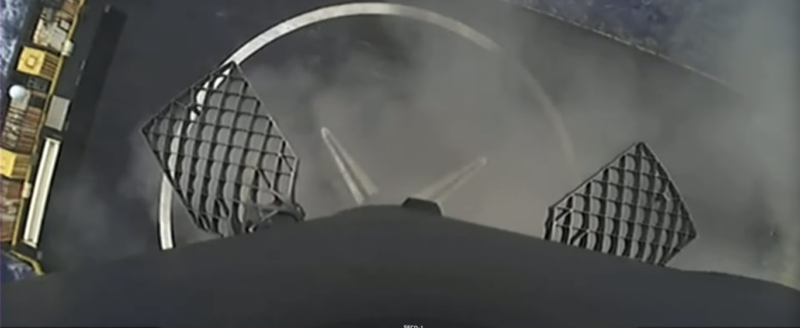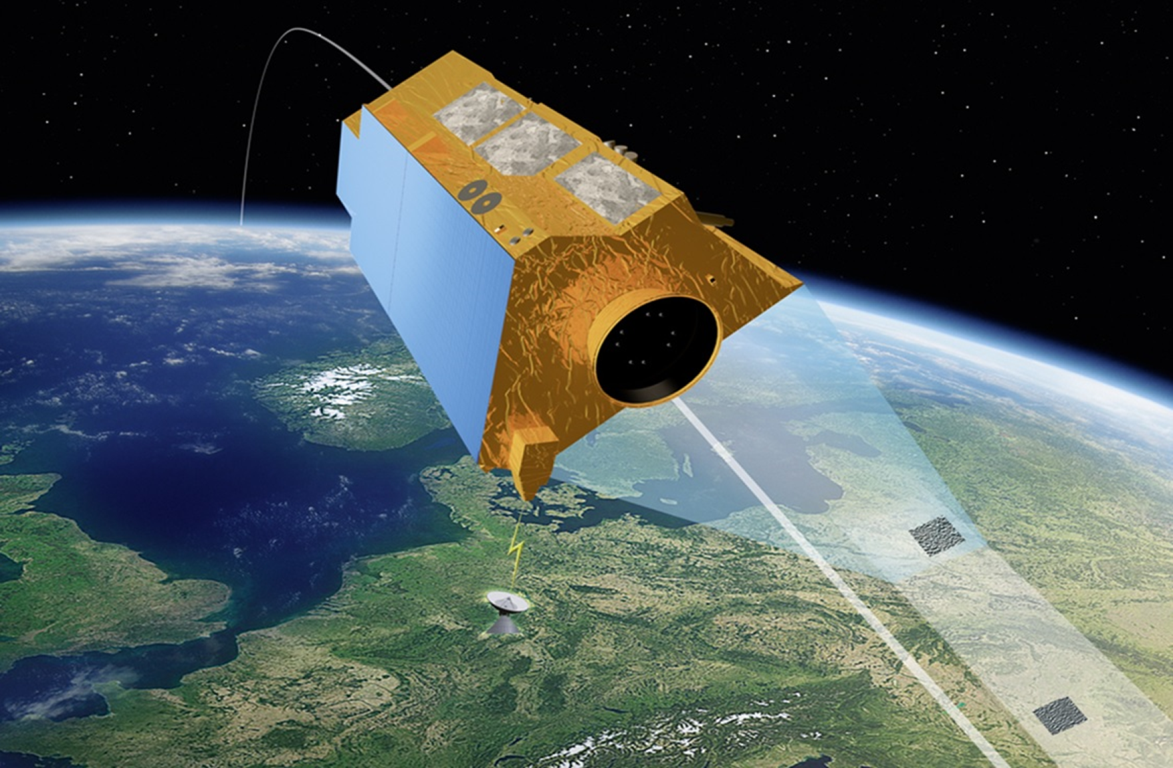
It is shaping up to be a case of “another week, another Falcon 9 launch”, as SpaceX presses on towards a record-setting raft of missions in 2022. A four-times-used booster successfully rose into murky skies from Space Launch Complex (SLC)-4E at Vandenberg Space Force Base, Calif., late Friday morning, carrying a 46-strong “stack” of Starlink internet communications satellites, destined for emplacement into low-Earth orbit.
With today’s launch, SpaceX officially eclipses its personal best for the greatest number of Falcon 9 flights and the highest-ever tempo of missions out of mountain-ringed Vandenberg in a single calendar year. Launch occurred 24 hours later than intended, following a scrub at T-46 seconds on Thursday and 24-hour recycle to Friday’s backup opportunity.
Last year, the Hawthorne, Calif.-headquartered launch services provider logged no fewer than 31 launches from three sites—SLC-4E at Vandenberg and storied Space Launch Complex (SLC)-40 at Cape Canaveral Space Force Station and historic Pad 39A at the Kennedy Space Center (KSC), both in Florida—using only ten booster cores, one of which flew no less than six times. Records were set for the shortest interval between two launches by the same orbital-class booster, the first all-civilian human spaceflight and the first time five Falcon 9s had flown in a single calendar month.

Fast forward to 2022 and SpaceX CEO Elon Musk has made little secret of his desire to stage 60 launches, an average of more than one per week. And with Thursday’s 32nd flight of 2022, and still only in the year’s 29th week, this lofty goal no longer seems unreachable.
Just last month, three Falcon 9s flew within 36 hours of each other. All told, those 32 missions have been undertaken, like 2021, using only ten boosters, five of which have already flown four times apiece since January, smashing turnaround records and logging SpaceX’s first-ever six-launch month.

And four flights certainly appeared to be the charm early Friday, as the B1071 core (which was still awaiting its first launch as 2022 began) became only the second Falcon 9 to roar aloft as many as four times out of Vandenberg. This booster supported a pair of highly classified missions—NROL-87 and NROL-85—on behalf of the National Reconnaissance Office in February and April, before lofting Germany’s SARah-1 surveillance satellite last month.
With today’s launch, Vandenberg has played host to seven Falcon 9 missions so far this year, exceeding the prior record of six flights in 2018. That raft of missions, which is expected to increase as 2022 burns into its second half, has been accomplished with only a pair of boosters, which might conveniently be labeled “Vandenberg Falcons”.

B1071 has shared the load with its sister B1063, five of whose six launches to date—including a 53-strong batch of Starlinks only ten days ago—have originated from the West Coast. B1063 has so far flown three times out of Vandenberg this year, in February, May and last week.
Under murky skies, Thursday’s countdown appeared to proceed normally, until an “Abort” call was heard over the communications network at T-46 seconds. Shortly thereafter, clocks were reset to T-15 minutes, before the Launch Director announced a scrub and 24-hour turnaround to the backup opportunity at 10:39 a.m. PDT Friday.

Today’s launch also marked the first landing of B1071 on the deck of an Autonomous Spaceport Drone Ship (ASDS), her three previous returns having alighted on solid ground at Vandenberg’s Landing Zone (LZ)-4. In support of the mission, the veteran ASDS “Of Course I Still Love You”—which supported 45 East Coast booster recoveries between April 2016 and June of last year, before relocating to Vandenberg—put to sea from Port of Long Beach earlier this week, bound for a position about 395 miles (635 kilometers) offshore.
Liftoff of B1071 on its fourth mission took place at 10:39 a.m. PDT Friday, the nine Merlin 1D+ engines powering the Falcon 9 smoothly uphill for the first 2.5 minutes of flight. The core stage then separated from the stack and completed a smooth touchdown on OCISLY about 8.5 minutes after liftoff.

Attention then turned to the single Merlin 1D+ Vacuum engine of the second stage, which burned for six minutes, then entered a lengthy “coast” phase before the expected deployment of the 46-strong Starlink stack about an hour into the mission. It was the sixth dedicated Starlink flight out of Vandenberg, which has so far seen almost 300 of these flat-packed satellites placed into orbit since last September.
Yet 2022 is far from over, with an anticipated ramping-up in the tempo of launches from the West Coast before the New Year’s Eve bell tolls. Although SpaceX reveals precious little in the way of a detailed flight manifest, there at least four more missions set to rise from Vandenberg before year’s end. And in today’s webcast, it was noted that the next Vandenberg launch—presumably another Starlink mission—is expected in just two weeks’ time.

A pair of “passive” SARah reflector satellites, flying on behalf of the German military, are expected to join the SARah-1 radar-imaging surveillance platform, launched last month. Added to that list is the planned September opening launch of the Tranche 0 Transport and Tracking Layer for the Space Development Agency (SDA), contracts for which were signed with SpaceX in January 2021 for an estimated total value of $150.45 million.
This will form the basis of an eventual “constellation” of 300-500 low-orbiting experimental satellites to furnish ground-based warfighters with “assured, resilient, low-latency military data and connectivity worldwide”. They are also equipped with Wide Field of View (WFOV) infrared sensors for hypersonic missile tracking.

Also in 2022’s final months, a Falcon 9 is set to deliver four WorldView Legion satellites to Sun-synchronous orbit for the Westminster, Colo.-based Earth imagery provider, DigitalGlobe. The Maxar-built Legion is expected to double DigitalGlobe’s capacity to gather the world’s highest-resolution geospatial imagery by resolving surface details as fine as just 12 inches (30 centimeters).
And later in the year, another Falcon 9 will lift the NASA-led Surface Water Ocean Topography (SWOT) payload to examine the changeability characteristics of surface water bodies over time. If all four of these launches are achieved, 2022 should end with a record-setting 11 Falcon 9 flights out of Vandenberg.

Yet that figure does not include an anticipated uptick in Starlink missions to loft the third “shell” of these low-orbiting internet communications satellites at an altitude of 350 miles (560 kilometers), inclined 97.6 degrees to the equator. The first members of Shell 3 were launched earlier in July and with today’s second flight a total of 92 satellites of an eventual 348 have been orbited.
Attention now turns back to the Space Coast, and specifically KSC’s Pad 39A, where another Falcon 9—widely expected to be the seven-times-flown B1062, which most recently delivered Egypt’s Nilesat 301 geostationary communications satellite to orbit in June—is due to launch another batch of Starlinks early Sunday morning. The ASDS “A Shortfall of Gravitas” put to sea from Port Canaveral on Wednesday to recover the booster about 390 miles (630 kilometers) offshore in the Atlantic Ocean.

Weather conditions are expected to be about 80-percent favorable for both Sunday and the backup opportunity on Monday, with a slight risk of violating the Cumulus Cloud Rule and Anvil Cloud Rule. The mission is expected to close out July as SpaceX’s second month to include as many as six launches.
“Low-level flow from the southeast will allow the east coast sea breeze to move inland
unimpeded, keeping most of the afternoon and evening convection west of the Space Coast,” noted the 45th Weather Squadron at Patrick Space Force Base in its Friday morning L-2 update. “Saturday will be much the same locally, with the addition of a mid-level trough creating enhanced cloudiness and precipitation coverage. On Sunday, this trough will bring the heightened instability to the vicinity of Spaceport, making the primary weather concerns the Cumulus and Anvil Cloud Rules.”






3 Comments
3 Pings & Trackbacks
Pingback:SpaceX Continues Ambitious Vandenberg Campaign, Eighth Launch of 2022 - AmericaSpace
Pingback:Four-Time Falcon 9 Continues Starlink Expansion - AmericaSpace
Pingback:Record-Setting “Vandenberg Falcon” Flies, as SpaceX Heads for 50th Launch of 2022 - AmericaSpace